Sustainable Water Systems for Homestead Survival
Discover essential sustainable water systems for homestead survival. Learn about rainwater harvesting, well drilling, and water purification techniques I use to ensure a reliable supply.
PREPPING POSTS
Kathrine-Anne Hill
10/23/20247 min read
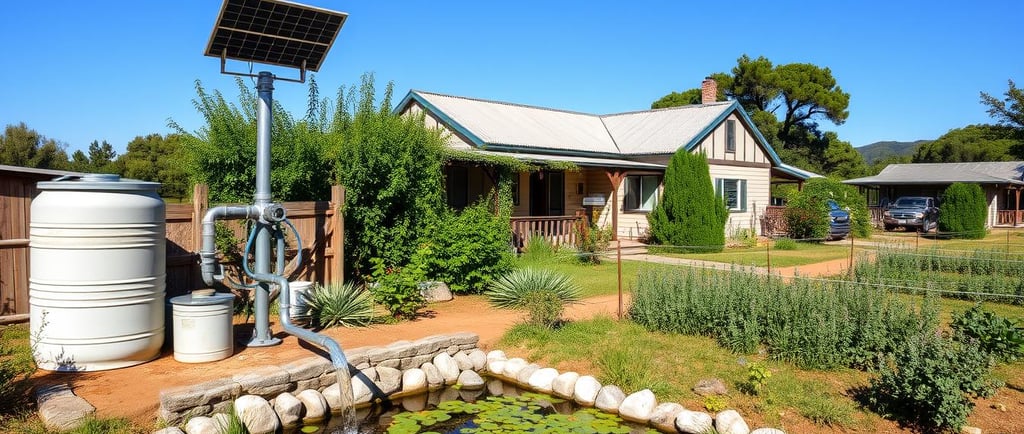

Affiliate Disclosure:
Please note that some of the links in this article are affiliate links. This means that if you click on these links and make a purchase, I may receive a small commission at no additional cost to you. This commission helps support the maintenance and growth of this website and allows me to continue providing valuable information and recommendations. Rest assured, I only recommend products and services that I have personally used or thoroughly researched. Your support is greatly appreciated! “As an Amazon Associate I earn from qualifying purchases.” For full disclosure see our Privacy Policy and Terms and Conditions here.
Sustainable Water Systems for Homestead Survival
Looking out at my off-grid homestead, I felt grateful for the freedom of living off the grid. A reliable water supply was key to making it work. It's the heart of any thriving homestead.
Having a steady, clean water source was vital. It showed my commitment to living with nature. I started learning about off-grid water systems, from getting water to managing wastewater.
If you're thinking about off-grid living or want to learn more, this guide is for you. We'll cover rainwater harvesting, using groundwater, and advanced purification. These strategies will help you create sustainable water systems for your homestead.
Key Takeaways
Sustainable water systems are essential for off-grid living and homestead self-sufficiency.
Exploring a variety of water sources, including groundwater, surface water, and rainwater, is crucial for ensuring a reliable supply.
Implementing effective water storage, filtration, and purification methods is key to maintaining a safe and clean water supply.
Careful consideration of water transport and weight limitations is necessary for homesteaders with limited access to heavy-duty vehicles.
Embracing a holistic, permaculture-based approach to water management can enhance the sustainability and resilience of your homestead.
Understanding Water Sources for Off-Grid Living
Starting an off-grid homestead means finding reliable water sources first. Not all rural areas have city water. Instead, homesteaders often use wells, springs, creeks, lakes, and rivers.
Groundwater Sources: Wells and Springs
Wells provide a steady water supply, but it depends on the area's groundwater. Deeper wells cost more but flow better. Shallow wells are cheaper but water flow changes with the seasons. Springs are reliable if the water flow is steady.
Surface Water Sources: Creeks, Lakes, and Rivers
Creeks, lakes, and rivers are good alternatives. But, they need more treatment because of possible contamination. Testing the water quality is key to make sure it's safe to drink.
Choosing the right water source is important. Testing the water quality is essential. This helps find the best treatment methods for safe drinking water in off-grid living. The Primed 20-in-1 Drinking Water Test Kit comes with 125 testing strips and 2 bacteria tests.
Rainwater Harvesting: A Sustainable Solution
Rainwater harvesting is gaining popularity for off-grid water needs. It's great when getting water from underground or surface sources is tough. By collecting and storing rainwater, homesteaders can have a steady water supply for everyday use.
These systems have a catchment area, like a roof, gutters, pipes, and a storage tank. The tank's size depends on the roof's area and how much rain falls in the area.
Rainwater harvesting systems can be a reliable water source for off-grid homes. But, in places like Colorado, laws might limit rainwater collection. Always check local rules before starting.
"The family in Arizona manages to run their entire house and grounds off rainwater all year round, indicating the sustainability of rainwater harvesting.
While rainwater collection is a good option, the water might need treatment. This is to remove harmful substances. Regular upkeep, like adding chlorine, helps keep the water clean and algae-free.
Off-grid water storage with rain barrels and cisterns is a smart and eco-friendly choice for homesteaders. With the right planning and care, rainwater harvesting can be a dependable water source for homes and farms.
Sustainable Water Systems for Homestead Survival
Living off-grid means having a steady water supply is key. After finding a water source, storing it right is vital. You can choose from rain barrels, cisterns, and custom water tanks for off-grid water storage.
Rain barrels hold 50 to 200 gallons, making them a handy choice. For more water, water tanks in plastic, steel, or concrete can be made to fit your space. Underground storage like cisterns keeps water cool and safe from pollution. The FCMP Outdoor RC45 BLK Rain Barrel holds 45 gallons and is highly rated. It has a debris screen, comes with a garden hose, shut-off thumb valve and has a safety rib keeping it child and pet safe. If you would like a more decorative look, the Algreen Castilla Rain Barrel holds 50 gallons and comes in a brownstone color.
For water storage there is the FlexiTank Collapsible Reservoir Water Tank which holds 265 gallons.
Planning is crucial for a good off-grid water storage system. Think about how much water you use, seasonal changes, and emergencies. This helps design the best water storage for your homestead.
Using sustainable water storage systems makes off-grid living better. Homesteaders can have a steady water supply, making their homes more self-sufficient. With many options like water tanks and underground cisterns, choose what works best for your homestead.
Water Purification and Treatment Methods
Having safe drinking water is key for any off-grid homestead. Natural water sources might look clean, but they can hide sediments, contaminants, and harmful pathogens. It's important to use the right water purification and treatment methods to keep your family healthy.
Filtration Techniques
Filtration systems are key for clean water. Carbon filters remove chlorine, lead, and more. But, they miss bacteria, viruses, and metals.
Ceramic filters catch bacteria well. Yet, they might not get viruses or chemicals.
Activated carbon filters are cheap for basic cleaning. But, they don't remove all pathogens.
Ceramic filters are better. They remove bacteria and some contaminants.
For the best water treatment, reverse osmosis and UV purification are top choices. They remove many impurities.
In emergencies, backup filters or boiling water can save lives. They ensure safe drinking water when systems fail.
"The water must be both filtered and purified to be considered drinkable. Water must have less than 10 parts per million (PPM) of impurities to be considered purified."
By mixing different methods, homesteaders can keep their water safe. This is crucial for off-grid living. The Sawyer SP129 PointOne Water Filtration System is portable for filtering water from rivers, lakes, or streams, can filter up to 100,000 gallons of water and removes greater than 99.99999-Percent of all bacteria and 99.9999-Percent of all protozoa. For water filtration for families on a homestead there is the Big Berkey Gravity-Fed Water Filtration System does not need electricity and is known for reliability and quality.
Conclusion
Having a reliable water supply is vital for off-grid living and homesteading in Canada. Homesteaders can choose from groundwater, surface water, and rainwater harvesting. This creates a self-sufficient system that meets their needs.
Homesteaders can use wells, springs, creeks, lakes, or new tech like desalination. The goal is a steady, safe, and green water supply. This supports your family's survival and growth.
Using water filtration and renewable energy makes your system secure and sustainable. This approach helps your off-grid homestead thrive and supports your community's well-being.
FAQ
What are the key components of creating an effective off-grid water system?
To create a good off-grid water system, find a water source, store it, filter it, and have power. Properly handling wastewater is also key. This ensures clean, reliable water for your home.
What are the common options for off-grid water sources?
You can use natural springs, wells, or collect rainwater for off-grid water. It's important to check the water quality and know about possible contaminants before you start.
How can rainwater harvesting be an effective solution for off-grid water supply?
Rainwater harvesting is a great choice for off-grid water, especially where springs or aquifers are hard to reach. A well-set up rainwater system can give you a steady, green water source for your home.
What are the options for water storage in an off-grid system?
You can store water in rain barrels, big cisterns, or custom tanks made from plastic, steel, or concrete. Underground tanks keep water cool and safe from outside harm.
What water treatment methods are important for ensuring safe consumption in an off-grid system?
Important treatments include settling, filtering, and adding chlorine. For even cleaner water, you can use reverse osmosis or UV purification. Having portable filters or boiling water can also help in emergencies.
Source Links
The Complete Guide to Off Grid Water Systems for Homesteaders – Rustic Skills Homesteading - https://homesteading.rusticskills.com/off-grid-water-systems/how-to-build-an-off-grid-water-system/
How To Purify Water On Your Off Grid Homestead - https://www.susprep.com/off-grid-water/how-to-purify-water-on-your-homestead/
5 Off-Grid Water Sources and Systems - https://homesteadsurvivalsite.com/off-grid-water-sources/
Off Grid Water Systems: Five Realistic Options - https://www.offgridlivingnews.com/blog/off-grid-water-systems-five-realistic-options
Off Grid Water Systems: Gravity Fed, Rain Barrels, Cisterns & Wells - Pure Living for Life - https://purelivingforlife.com/off-grid-water-systems/
The Perfect Rainwater Collection System for Homesteaders and Urban Gardeners — Green and Prosperous - https://www.greenandprosperous.com/blog/the-perfect-rainwater-collection-system-for-homesteaders-and-urban-gardeners
Rainwater harvesting - https://survivaljack.com/2021/01/rainwater-harvesting/
How Rainwater Cisterns Filter Water - Verge Permaculture - https://vergepermaculture.ca/how-rainwater-cisterns-filter-water-2/
Getting Started With Off-Grid Water System For A More Self-Reliant Homestead • Insteading - https://insteading.com/blog/off-grid-water-system/
Grey Water Guide to a Nearly Endless Water Supply - https://survivaljack.com/2022/06/grey-water-guide-to-a-nearly-endless-water-supply/
11 Methods For Off Grid Water Filtration And Purification Guide – Rustic Skills Homesteading - https://homesteading.rusticskills.com/water-filters/off-grid-water-filtration-purification/
The Complete Guide To Off-Grid Water Systems - Today's Homeowner - https://todayshomeowner.com/lawn-garden/guides/complete-guide-to-off-grid-water-systems/
Getting Started: WATER | Modern Homestead - https://modernhomestead.com/uncategorized/getting-started-water/
The Ultimate Guide to Off-Grid Water Solutions for Preppers [2024] - Jake Tanner % - https://jaketannerprep.com/offgridwatersolutionsforpreppers/
Off-Grid Living - https://survivalgals.com/resources/off-grid-living
Off Grid Living: What You Need to Know - https://melissaknorris.com/podcast/off-grid-living-what-you-need-to-know/

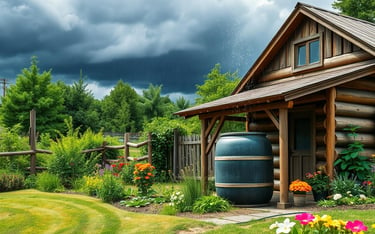


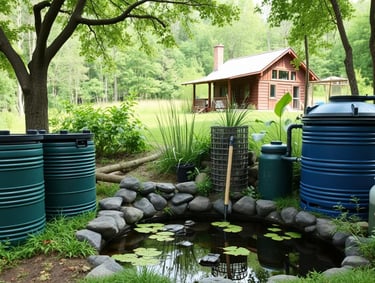

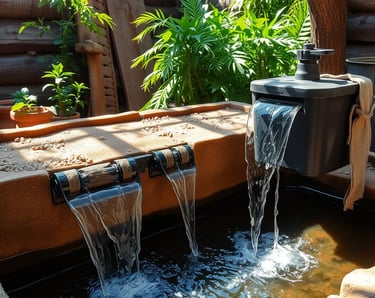
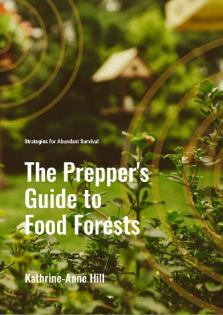

The Prepper's Guide to Food Forests: Strategies for Abundant Survival is a concise, step-by-step guide to creating a self-sustaining food forest. Ideal for preppers, it covers essential topics like design, plant selection, permaculture, companion planting, and wildlife integration. Learn how to maintain your forest, boost yields, and make it part of your survival strategy.
Highlights:
Basics of food forests and their benefits
Designing and selecting resilient plants
Creating a self-sustaining ecosystem
Using permaculture and companion planting
Maintenance, harvesting, and wildlife habitats
Food forests as part of a prepper strategy
Perfect for anyone seeking long-term food security.
Sign-Up and receive my FREE eBook The Prepper's Guide to Food Forests: Strategies for Abundant Survival !
As always, be sure to check our website for more wilderness tips and gear updates!
